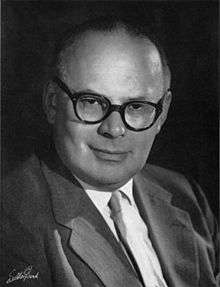Rudolf Wittkower
| Rudolf Wittkower | |
|---|---|
 Rudolf Wittkower, 1967 | |
| Born |
22 June 1901 Berlin, Germany |
| Died |
11 October 1971 (aged 70) New York City, NY, U.S. |
| Occupation | Art historian |
Rudolf Wittkower (22 June 1901 – 11 October 1971) was a German-American art historian specializing in Italian Renaissance and Baroque art and architecture.[1]
Biography
He was born in Berlin to Henry Wittkower (1865–1942) and Gertrude Ansbach (Wittkower) (1876–1965).[1] He moved to London in 1933 with his wife Margot Holzmann because they were both Jewish and were fleeing Nazi Germany.[2] He taught at the Warburg Institute, University of London from 1934 to 1956, was appointed Durning Lawrence professor at the Slade School of Fine Art, University College, London in 1949 and then moved to the United States to work at Columbia University from 1956 to 1969 where he was chairman of the Department of Art History and Archaeology.
Wittkower's Architectural Principles in the Age of Humanism introduced an in depth analysis of Venetian architect Andrea Palladio and his relation to sixteenth century music theory. Part Four specifically deals with how and why Palladio adapted harmonic musical ratios and incorporated them into the physical proportions of his buildings. Although this theory of Palladian proportions was universally accepted after the book's release, recent works in art history have made it the subject of much controversy. Wittkower had encountered this notion that musical harmony may act in a manner analogous to visual harmony in Pythagoras, where it was also noted by Alberti.[3]
He was awarded the Alice Davis Hitchcock Award posthumously in 1975 for his book Gothic vs. Classic, Architectural Projects in Seventeenth-Century Italy.[4]
Publications
- Architectural Principles in the Age of Humanism (1949)
- Bernini: The Sculptor of the Roman Baroque (1955)
- The Arts in Western Europe: Italy in New Cambridge Modern History, vol. 1 (1957), pp. 127–53
- Art and Architecture in Italy, 1600–1750 (1958, and revised editions)
- Born Under Saturn: The Character and Conduct of Artists (1963, co-authored with Margot Wittkower)
- The Divine Michelangelo (1964,co-authored with Margot Wittkower)
- Gothic vs. Classic, Architectural Projects in Seventeenth-Century Italy (1974)
- Sculpture: Processes and Principles (1977, co-authored with Margot Wittkower)
References
- David Rosand. Making Art History at Columbia: Meyer Schapiro and Rudolf Wittkower. Columbia Magazine.
- Deborah Howard. "Four Centuries of Literature on Palladio", The Journal of the Society of Architectural Historians, Vol. 39, No. 3 (Oct., 1980),224-241.
- 1 2 Sorensen, Lee (27 November 2000). "Rudolf "Rudi" Wittkower". Dictionary of Art Historians. Retrieved 30 June 2014.
- ↑ "Margot Wittkower, neé née Holzmann". Dictionary of Art Historians. Retrieved 30 June 2014.
- ↑ Wittkower, Rudolf (1940). "Alberti's Approach to Antiquity in Architecture". Journal of the Warburg and Courtauld Institutes. London: Warburg Institute. 4 (1/2: Oct., 1940 - Jan., 1941): 1. JSTOR 750120.
- ↑ Cramer, James P.; Yankopolus (1 November 2005). Almanac of Architecture & Design 2006. Greenway Communications. p. 53. ISBN 0975565427.